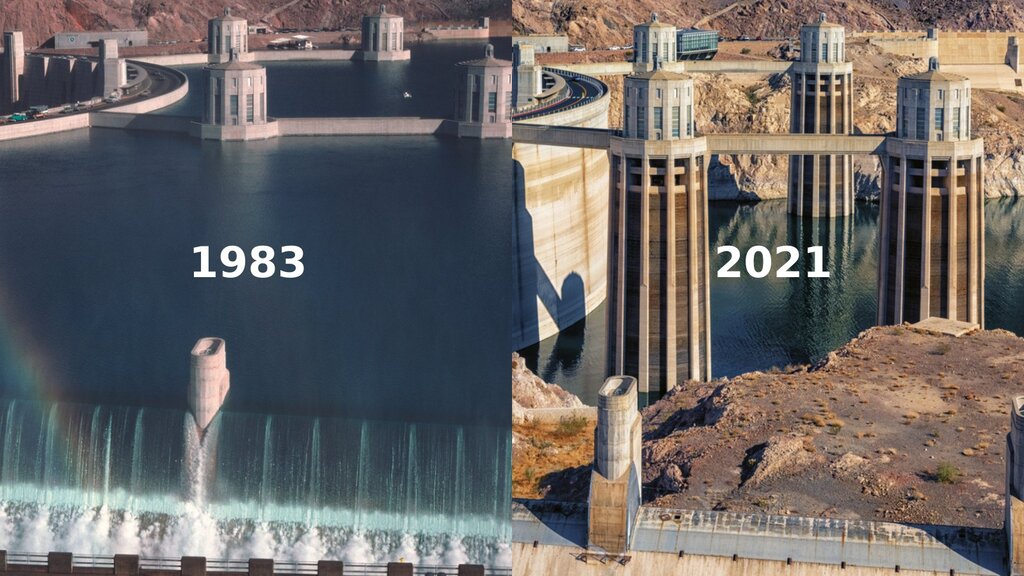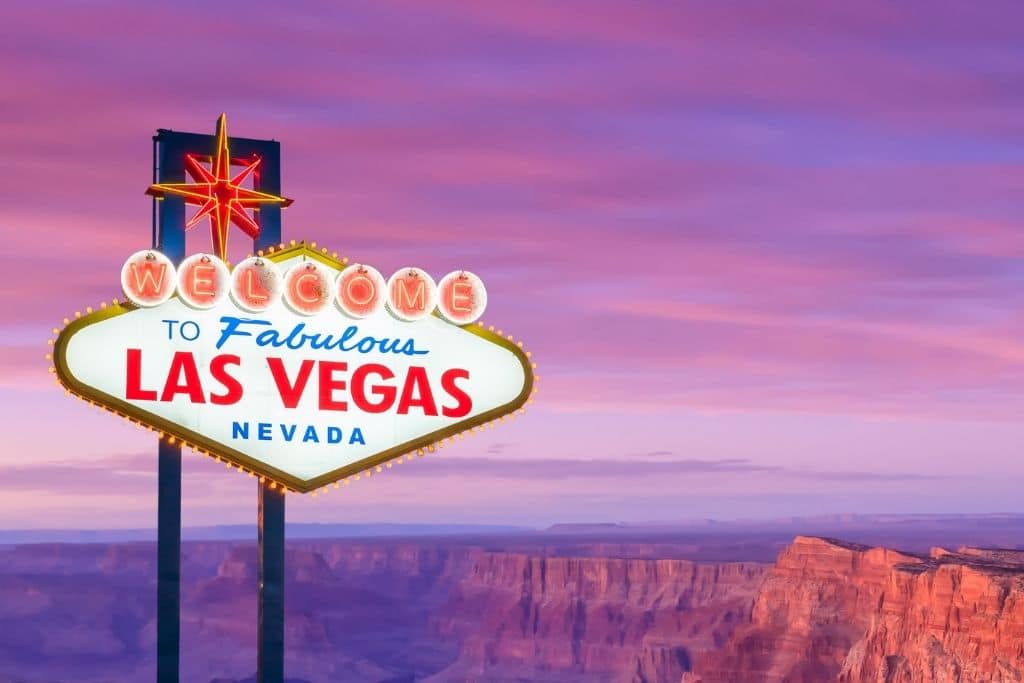The Las Vegas water shortage in 2021 revealed the growing threats of water security as the planet continues to warm. The city and the larger county have successfully implemented a number of water conservation measures, but are they enough to tackle the dwindling water levels from Lake Mead?
—
Every year (at least in pre-pandemic times), Las Vegas attracts a staggering 42.5 million tourists for a taste of its glittering casinos, luxury resorts, and the miniature replica of Paris’ Eiffel Tower. But behind its glamorous facade, the city is confronted with a growing myriad of issues amid a worsening climate crisis.
Situated within a basin on the floor of the Mojave Desert, Las Vegas has been hit hard by rapidly rising temperatures, where temperatures have soared up to 46.6C (116F) in June 2021, smashing previous records. During the same summer, Clark County, in which Las Vegas is located, recorded 124 heat-related deaths. Average hot weather has also been on the rise while annual precipitation has plummeted down to just 21 days with only four inches (100 mm). Though when rainfall does occur, it can be torrential and often triggers highly destructive flash floods.
Just 160km (about 100 miles) west of the city is the notorious Death Valley national park, one of the hottest and driest places in the country, which logged an unprecedented 54.4C in 2020. In fact, the US Climate Data says Las Vegas is the fastest-warming city in the US, soaring nearly 3.3C (6F) on average since 1970.
At the same time, Vegas has been in the midst of a population boom. Home to about 2.3 million people, the city’s population is set to rise up to 4 million by 2055 thanks to its attractive, cheap costs of living and lower tax rates, driving the arid city to develop more shopping malls and attractions closer to its rocky hillsides.
Together, the combination of decreasing rainfall and dryer conditions exacerbated by the changing climate, along with a growing population, are putting a strain on the water supply and security in Las Vegas.

Las Vegas Water Sources
So where does Las Vegas get its water from? The arid region largely depends largely on the increasingly drought-stressed Lake Mead and Colorado River for its supply of water. Providing 90% of the city’s water use and consumption, the Hoover Dam Reservoir holds Nevada’s annual water share of 300,000 acre-feet or 97 billion gallons.
But this precious water source, which also supplies water to six other states – California, Arizona, New Mexico, Colorado, Wyoming and Utah – is under significant pressure from climate change and worsening drought conditions.
According to a recent report, the period between 2000 and 2019 was also its driest stretch in more than 100 years of record-keeping, culminating in the unprecedented low water levels in Lake Mead and subsequent Las Vegas water shortage in 2021. In response, the US federal government issued its first-ever water shortage declaration on the Colorado River while Southern Nevada’s water allocation was reduced by 7 billion gallons, which is enough water to serve 45,000 homes, to 279,000 acre feet of water. For Las Vegas and the state of Nevada, annual usage is reduced by 7%, which is about 6.8 billion gallon of water. The shortage will run for a year and be renewed annually depending on conditions, or it will be repealed once water levels at Lake Mead return to 1,075 feet.
Climate experts warn that water levels in the river basin will likely continue to drop as the planet continues to warm, driving less moisture in soil and land surfaces and leaving less water to run off or flow to downstream reservoirs. Coupled with soaring water demand from population and urban development growth, not only will desert communities become thirstier, so will wildlife and vegetation.
You might also like: Lake Mead and Colorado River Basin Water Shortage: Causes, Effects, and Policy Solutions
Las Vegas Water Shortage Solutions
The Southern Nevada Water Authority (SNWA), the government agency that is in charge of and manages the region’s water needs, is seeking to drive down daily per capita water use amid increasing threats to water security. Currently, Las Vas consumes about 112 gallons of water per day. The goal is to cut that down to 998 gallons by 2035, despite projections indicating per capita water use could increase by nine gallons a day to adapt to global warming.
The agency is betting on water conservation to meet that goal, which has proven to be quite successful so far. NWA’s water conservation campaign has helped cut its Colorado River consumption by about 23% and per-capita water use by 47% between 2002 and 2020 despite increased water demand from the arrival of 780,000 new residents.
One of the key targets in reducing and conserving water is putting limits on its uses on outdoor landscaping and a surprisingly vast number of golf courses. Las Vegas has converted large parts of its desert landscape into recreational lawns and lush terrain for golfing activities, and is now home to more than 50 golf courses. But the new developments and maintenance drink up significant amounts of water – making outdoor landscaping the largest consumptive water user in Southern Nevada – with golf courses and resorts responsible for 10% of the water supply. The average customer demand for water (mostly for outdoor irrigation) can be 50-80% higher than in the East coast, according to the Water Research Foundation.
This is why for the past two decades, the SNWA has paid homeowners to either get rid of their grass or pay USD$3 for every square foot of grass replaced with water-smart landscaping. Since 2003, lawns are banned from being installed in the front yards of new homes and grass is prohibited in commercial developments. A recent bill passed by the Nevada Legislature will also prohibit Colorado River water from being used to irrigate ornamental grass on non-residential properties starting in 2027. Lawns that don’t have recreational use are being outlawed, with plans for full eradication by 2026.
Other water conservation strategies the agency is pushing include eliminating complimentary water at restaurants. A glass of water not served at a restaurant saves about three gallon, with consideration of the amount of water needed for cleaning, ice production and the glass of water itself.
Aside from conservation efforts, the SNWA has the foresight to build a new (and third) intake tunnel under Lake Mead, at a cost of nearly USD$1 billion, to ensure it could continue to draw water from the reservoir. Concurrently, the agency oversees a recycling system that makes sure 99% of indoor water is treated and returned to Lake Mead.
But much more needs to be done to tackle water shortage in Las Vegas. There are discussions of adding “a luxury tier” to water bills ultra-high-end homes that use nearly 10 million gallons or more a year. The SNWA is also looking to target another major water user: evaporative cooling towers that keep the city’s commercial and industrial buildings cool. Adopting new efficient technologies such as air conditioning could potentially save more than two gallons per person per day.
But the biggest question remains whether the region and the city conserve enough to survive declining water levels at Lake Mead. The latest report by the Intergovernmental Panel of Climate Change concluded that there will be an increase in intensity or frequency of droughts in many regions around the globe. But as Vegas continues to add new suburbs and cul de sacs, invite more cars on the roads and therefore more concrete – which has a massive carbon footprint – the city will need to prepare to look for new sources of water and rapidly decarbonise.
You might also like: US Drought: What are the Causes, Effects and Solutions


















